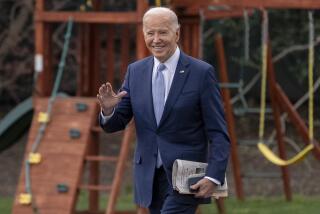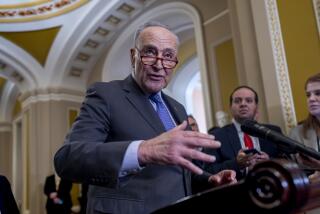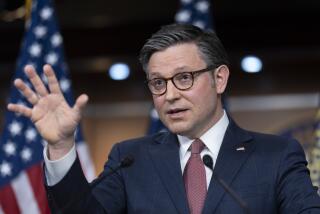Airlines, Mail Will Be First to Face Disruption
WASHINGTON — As the federal government begins shutting down operations this weekend because of the continuing budget stalemate, Americans will encounter almost immediate disruptions of commercial air traffic and perhaps some delays in mail delivery.
With those exceptions, however, few people are likely to notice the abrupt cessation of federal services until Tuesday, when civil servants normally would return to work after the Columbus Day holiday.
That’s when virtually all federal workers--except for the military, law enforcement personnel, postal employees and medical providers--will be sent home if Congressand the White House have not managed to resolve the budget impasse.
Federal employees in Orange County, like those around the country, were facing a long weekend of uncertainty after being told Friday that they could be put on furlough when they return to work Tuesday.
If there is no new budget or resolution to continue government funding, “we will arrange for the orderly shutdown of our offices and send people home. If there is a resolution, then we will work on those terms,” said Dirk Murphy, spokesman for the Department of Housing and Urban Development regional office in San Francisco. There are about 80 employees in the agency’s fair housing and equal opportunity office in Santa Ana.
Employees of the Social Security Administration, which has 200 workers at eight offices in Orange County, have been told “to operate on a normal schedule at least Tuesday and Wednesday,” said Eddie Cooksey, spokesman at the agency’s regional office in San Francisco. By Tuesday “we’ll know what, if any, type of furlough we’ll have to go under.”
Last week, as the Oct. 1 budget deadline approached, Social Security employees in the eight Orange County offices and throughout the nation were told their offices would shut down on Fridays and that they would work only six hours a day, Monday through Friday, if no new spending plan was approved.
At every agency around the nation, from Social Security offices to agricultural extension branches, a small number of workers will stay on board temporarily to begin the process of shutting down operations and sealing up offices.
The shutdown will be far more extensive than the funding cuts and furloughs expected under the Gramm-Rudman deficit-cutting law, which would have reduced financing for many federal agencies by about a third.
The Gramm-Rudman cuts could have taken effect if a stopgap funding measure had been signed into law in the absence of an acceptable deficit-reduction plan. The shutdown is required because no temporary funding measure was signed by President Bush.
Even under a total shutdown, however, a few services associated with government will be spared. U.S. Postal Service operations will not be directly affected because the agency is self-supporting through stamp sales and fees for various services, but it will face disruptions in the heavy volume of mail it moves by air. Mail will be delivered as usual today, officials said.
Amtrak will not be affected for weeks, perhaps months, according to a spokeswoman. That is because the $519 million in annual operating funds it receives from Washington accounts for l ess than 30% of its yearly budget. In fact, an Amtrak official said late Friday that the railroad was exploring the possibility of increasing services--particularly adding cars to its regular runs in the busy Northeast corridor--to help offset cutbacks in air service.
In addition, all “essential” federal personnel responsible for protecting life and property will stay on the job. That includes security guards at Ft. Knox, doctors and nurses at the National Institutes of Health and law enforcement personnel of all stripes, including the Border Patrol, Customs inspectors, prison guards and the Coast Guard.
“The San Ysidro crossing will remain open,” a U.S. Customs official declared. “Goods and people will continue to be processed.”
A Pentagon spokesman said late Friday that all Department of Defense personnel involved in national security would remain at work, including many civilians. But he refused to be more specific, saying, “We don’t have everything all spelled out yet.”
Among the other effects of the government shutdown: Lights at the Statue of Liberty will be turned off. Tours of the White House will be canceled. National parks will be open, but there will be no rangers to patrol them--or to collect admission fees.
Judge David H. Souter’s swearing-in as the newest member of the Supreme Court will still take place Tuesday morning, but a White House reception for him was canceled.
Although negotiations to resolve the budget stalemate continued into Friday night, Budget Director Richard G. Darman issued a statement instructing all agency directors to prepare closing down operations this morning.
One of the few agencies that will be buffered from an immediate and total shutdown is the 4,800-employee National Weather Service. It has sufficient funds left over from the just-ended fiscal year to continue some operations through mid-October, a spokesman said.
As a result, the service will be able to keep its 250 stations open for 12 hours a day--from 6 a.m. to 6 p.m.--rather than closing them entirely. Normally, they are open around the clock.
But, without night weather forecasts normally provided by the service, there can be no night flights--even though the Federal Aviation Administration’s 17,200 air traffic controllers will remain on duty as “essential” personnel.
“They (pilots) have to have weather reports. Or else they’re not going any place,” said an FAA official.
The lack of night flights will delay mail service because significant amounts of mail are transported overnight, according to a Postal Service spokeswoman.
At the Social Security Administration, officials were making contingency plans to send nearly all 63,000 employees home Tuesday morning.
The Internal Revenue Service said it, too, would start a “total shutdown” Tuesday morning, retaining only security personnel to guard IRS installations.
At the National Institutes of Health, in addition to doctors and nurses, other “essential” personnel will include some who feed and care for the thousands of research animals in the laboratories, ensuring the integrity of hundreds of ongoing scientific experiments, a spokesman said.
Staff writers Tom Redburn, David Lauter and Marcida Dodson contributed to this article.
RELATED STORIES: A28, 29
More to Read
Sign up for Essential California
The most important California stories and recommendations in your inbox every morning.
You may occasionally receive promotional content from the Los Angeles Times.










